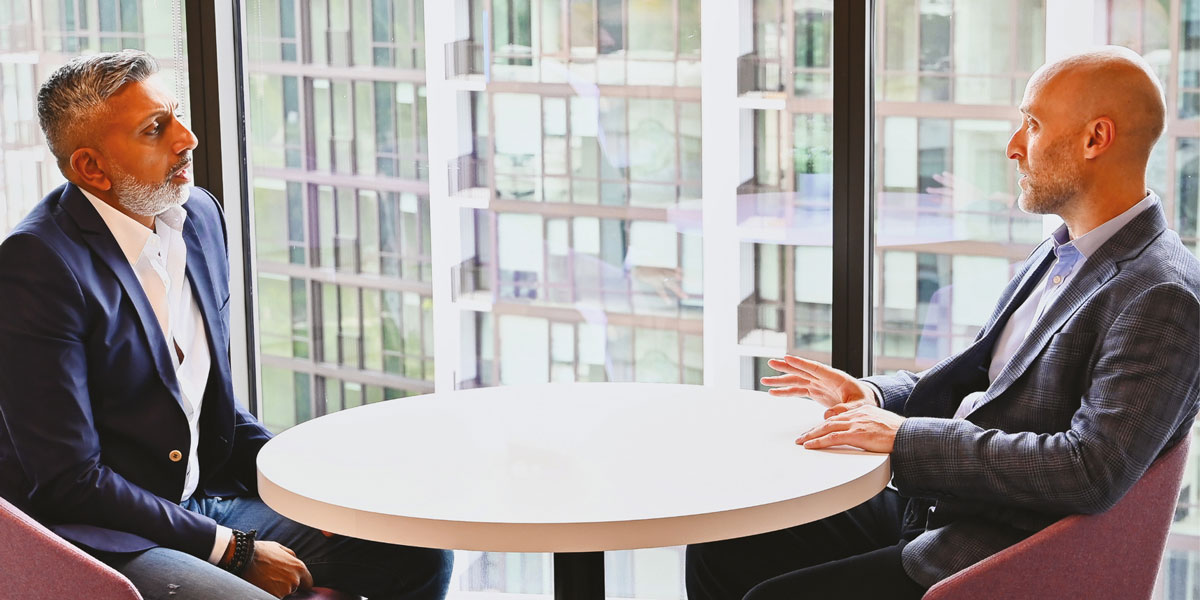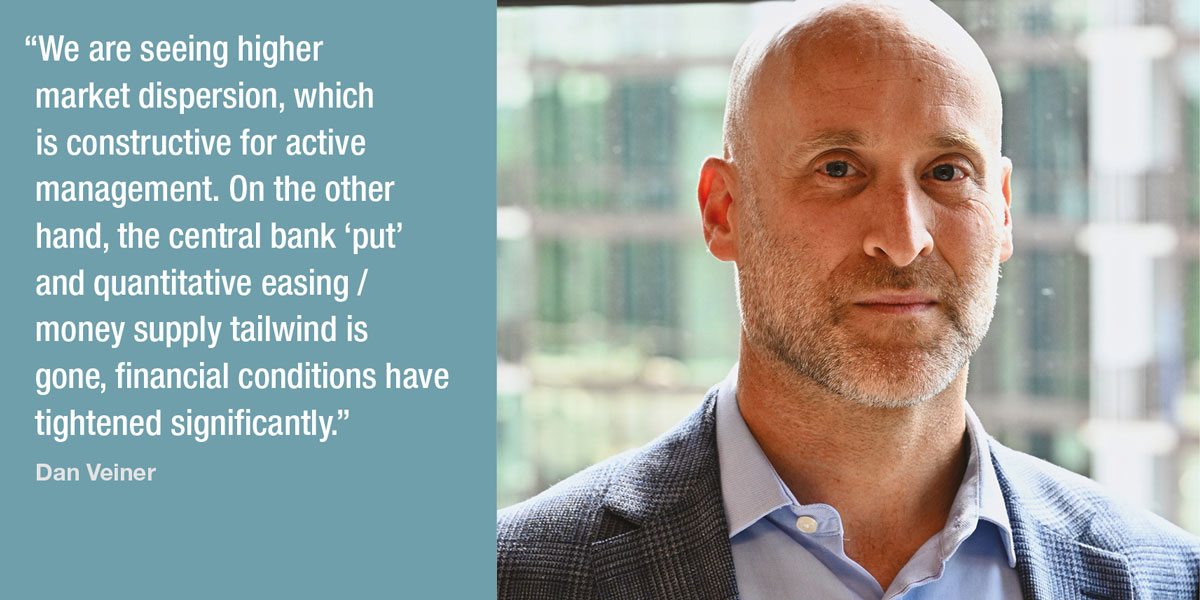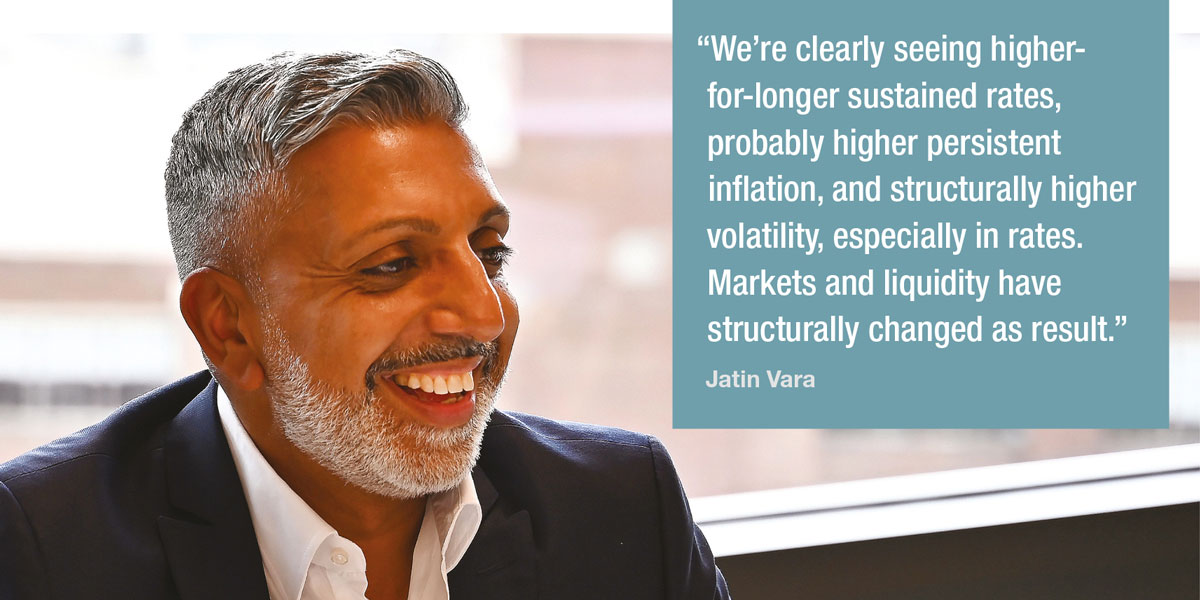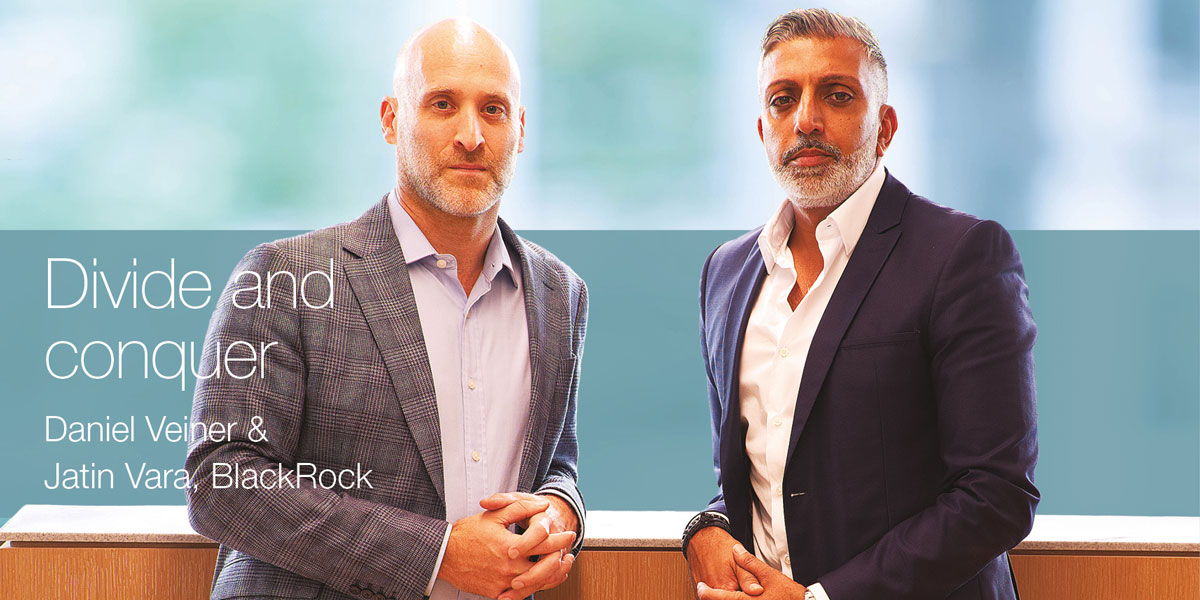The DESK interviews the team delivering continuous management of trading, for the world’s largest collective assets under management.
How do you divide management between you?
Dan Veiner (DV): Our approach is hybrid. We collaborate on all important issues, but we use our time zones and locations to our advantage. Jatin is in a better time zone for international business outside of the US. We take dual reporting lines for each asset class head.
Jatin Vara (JV): The point is to divide and conquer the task in hand – we’re both available at all times should someone need us. We have designated product and regional coverage, and it makes it easy for BlackRock and external partners to understand where we are, and who they need to call.
What sizes are the teams and operations that you are managing?
JV: We have 220+ people across 11 offices in Europe, the Americas including Mexico, and Asia. The team includes traders, business managers, and our e-trading and market structure team, which oversees electronic trading, market structure, trading research and transaction cost analysis initiatives. We execute over 50,000 trades per day, with US $15+ trillion in notional volume traded last year. Having dedicated asset class trading desks in local time zones enhances our ability to strategically access markets and execute trades on behalf of all portfolio management teams at the firm. Our size and scale serves as a distinct advantage, uniquely positioning us to access liquidity, minimise transaction costs, and deliver consistently strong execution – providing the best service to our investment teams and achieving optimal outcomes for our clients.
How would you describe your leadership styles?
DV: We strive to be firm but fair. No one likes to be micromanaged, so we empower and resource our leaders to help them excel. We also walk the floor, join the traders, dive into details, and solve problems. We balance our leadership style between having a big picture of the business and diving in when needed.
JV: I believe in maintaining an open line of communication with the team and make a point of having that constant dialogue about markets and the overall performance of our business. We both operate under an open-door policy, fostering a transparent and collegial culture within our organisation.
Clarity in our trading strategy and setting achievable goals are paramount. This approach ensures that the team has a clear understanding of their roles and responsibilities, and what they need to do to contribute to our collective success.

What interests do you have outside of work?
JV: My kids are different ages to Dan’s, I have two young boys and I’m basically ferrying them from one activity to another, mainly sports. Football is the shared passion; you’ll see me training on the pitch with the kids on most weekends and when we’re not doing that you will find us at the Arsenal stadium watching games. My other passion is being on the slopes snowboarding.
DV: I’ve lived and worked in many places: Canada, San Francisco, London and New York. But nowhere else have I seen such a focus on sports and extracurriculars as in the north-east of America. The kids here have very structured lives. I had free time to get into trouble as a kid, but they don’t. Like Jatin, I love sports too, especially Squash and Skiing.
How would you characterise the credit and rates market structures from the perspective of a buy side trader?
DV: Credit, rates and munis are OTC principal-based markets, while exchange-traded markets are much more conducive to agency trading and are more electronic, with centralised exchanges, versus a fragmented liquidity picture in OTC markets. OTC fixed income is characterised by a significant amount of voice/chat dealing. In credit, securitised and muni markets, there is a heterogeneity problem, with the top 10 issuers having over 10,000 CUSIPs/ISINs outstanding.
JV: The rates markets are more mature from an electronic trading/data perspective allowing for greater standardisation and automation which continues to be a focus for our platform. We’re also seeing credit markets experience a surge in electronic trading functionality from algorithmic trading, portfolio trading and further expansion of the exchange-traded fund (ETF) ecosystem. Each sector has its unique characteristics and requires in-depth market expertise for effective trading.
As we build our teams and strategise for the future, we pay close attention to these nuances. Our structure is built on the principle of specialisation. We have regional sector experts and product specialists, but we also ensure there’s overlap to provide resilience to our platform.
Which trends are shaping markets today?
JV: With the redistribution of risk taking, we’re witnessing a shift in market share as more alternative or principal trading firms continue to build their trading franchises. The bond market is also undergoing a transformation with increased electronification and standardisation. This is happening in a world where we have shifted away from an extended period of declining interest rates, low macro-economic and market volatility. We’re clearly seeing higher-for-longer sustained rates, probably higher persistent inflation, and structurally higher volatility, especially in rates. Markets and liquidity have structurally changed as result.
DV: Something that is a significant concern amongst the banks is the Basel III endgame proposal. This is also a significant concern for the buyside, given the likely impacts on trading and liquidity.

Changing liquidity provision from purely risk-based as it was historically to much shorter term support by proprietary trading firms does appear to create very different patterns.
DV: That’s right, and a handful of principal trading firms (PTFs) have broken in, leading with technology and market making acumen. Yet the barrier to entering the market in any capacity is much higher now due to the high cost of capital, and the expense and complexity of building out a distribution network. Most PTFs have focused on exchange-traded markets because the barrier to entry is lower.
JV: The other trend, is that finding alpha becomes harder. There’s no free ride here. We are seeing more complex workflows and packages, and we spend a lot of time thinking about the plumbing to make sure we get that right from a process and trading perspective, to manage that complexity. Markets are evolving, and there’s a lot of inter-dependant strategies so we continue to focus on this.
DV: That’s an excellent point on the challenges of creating alpha. We are seeing higher market dispersion, which is constructive for active management. On the other hand, the central bank ‘put’ and quantitative easing / money supply tailwind is gone, financial conditions have tightened significantly.
If you could change something to make market structure more optimal for your traders, what would it be?
JV: Sitting here in Europe, the evolution of the consolidated tape is an important journey to be on. The democratisation of data, and its increased availability, simplifies tasks for us as we navigate towards greater automation. This progression not only optimises our operations but also enhances market efficiency for end investors.
DV: Structurally, we would like to reduce fragmentation of data and liquidity.
Where do you see regulation having the biggest impact today on markets?
JV: In my view, the most significant impact stems from the regulatory environment’s impact on banks. The traditional market-making has undergone a transformation and it has profound implications on markets and liquidity.
Our dialogues with liquidity providers are evolving in response to these changes. The shift in regulatory landscape is not just reshaping our operations, but also redefining our interactions within the industry.
What are your expectations for the progress and evolution of electronification in fixed income?
JV: While adoption of fixed income has been slower than other asset classes, the current macroeconomic environment would suggest an increase in flows towards the asset class particularly considering the current yield levels. This could lead to an influx of investment and AUM in fixed income markets, including cash, derivatives, and ETFs.
This shift will further drive the modernisation of fixed income markets. The interplay between these factors is crucial; for instance, increased investment generates more data, which in turn supports further automation.
With the standardisation of this data, we should expect a surge in electronic trading and automation. Our focus is on enhancing efficiency by reducing the number of clicks required for transactions, thereby enabling our team to concentrate on high-touch, complex flows.
We are striving for streamlined order routing and more actionable liquidity, with metrics playing a pivotal role in decision-making. This approach not only optimises our platform but also paves the way for future growth and innovation in the fixed income markets.

DV: I started my career in equities and moved into fixed income later, where the contrast is stark. It’s apparent there’s still a long way to go just in the basics of electronification – straight-through-processing, agency algorithms – and you’re starting to see that evolve. Instruments like total return swaps (TRS) are ripe for electronification. In credit, an unforeseen moderniser has been the rise of fixed income ETFs. We talk about the three legs of the stool that are important to building up a credit franchise on the sell side. The most successful dealers have strong capabilities in terms of credit algorithms; portfolio trading capabilities; and fixed income ETF capabilities in primary and secondary markets. The most successful companies in building these capabilities have continued to take market share.
We have heard that making the economics work for dealer algorithmic trading can be hard.
DV: It requires significant investment in technology and research to do well. Some institutions have invested but haven’t seen the best results. Those who have done it properly have found it rewarding.
Which technologies do you think are providing most value to your traders at the moment?
DV: We are well resourced at BlackRock. We have an e-Trading team that manages our EMS and analytical tools. Our EMS is heavily customised to handle our complex trading workflows. We utilise technology to handle our AUM and trading growth versus continually expanding our trading team. Our customised EMS, trading tools and analytics keep us positioned for the future.
JV: As the regulatory and environment changes, we are building tools that make us more self-sufficient and minimise our footprint to the external ecosystem. Our pre-trade decision making tools process data to make decisions more quantifiable before we pick up a phone or press a button. This helps to optimise our internal liquidity.
Given the substantial volume we handle, it’s crucial that we only approach the market with the liquidity that is necessary. Our ongoing efforts to enhance our Order Management System (OMS) – Aladdin*, are a testament to this commitment. Increasing direct connections into Aladdin is a priority for us, as we constantly strive to streamline the trader’s experience and reduce their friction in finding liquidity. This is achieved through bilateral connectivity and pre-trade analytics.
What is the split of internal and external development of technology?
DV: Aladdin is our core trading operating system. Since stability is a priority, system enhancements are employed in a measured fashion. Therefore, we utilise a tactical solution to address our shorter-term needs.
We empower citizen developers in trading to help build tools and analytics for our trading desks. In-between Aladdin and our own citizen developers, we have our e-Trading team we’ve mentioned, and they deal with addressing needs in terms of connectivity, adding new venues and trading protocols (to name a few).
We regularly partner with the major trading venues to make sure they’re developing according with our needs, and the needs of the industry.
Going back to that point of difference between exchange-traded and OTC markets, don’t venues have to provide more of the trading workflow?
JV: While external platforms do provide the service we also strive to innovate and build some of that ‘quarterback’ in our own OMS reducing dependency risks.
What’s your position on the need for traders to develop data literacy and coding skills?
JV: In the modern trading landscape, the fusion of trading and coding skills is becoming increasingly important. We believe that some traders should be able to code, and coders should be fluent in trading and understanding markets. This dual competency is something we actively seek in our trading group, as well as across our investment platform.
We have established innovation hubs, such as the one in Atlanta, where we’ve grown a team of traders over the past two years. These individuals were initially hired for their coding skills and are now learning to trade. They form part of our systematic trading group, exemplifying a balanced approach to skill development.
We also use a large coding group within the trading function, comprising over 50 individuals. You can either be a newbie and learn to code and get assistance, or a seasoned coder, teaching and writing code.
This team plays a crucial role in developing tools that enhance our processes and aid in risk management. The ability to streamline manual processes through automation has proven to be a significant advantage for us. It provides additional capacity for risk management and helps circumvent potential backlogs in resource allocation and development.
How are you supporting development of diversity on the desk and what impact do you think diversity potentially has?
JV: Diversity, Equity, and Inclusion (DE&I) is organic in everything we do and the commitment comes from the top of the organisation. DE&I is formally part of our objectives, and we are measured on these objectives at the end of the year.
Diversity is multifaceted. In the context of trading, we are staunch advocates for diversity across the organisation. It enables us to cultivate a broad and diverse talent pool across the various asset classes we manage. Our commitment to DE&I not only enriches our workforce but also enhances our performance in the markets.
DV: I have the privilege of being our DE&I co-lead for BlackRock Global Markets. Global trading reports into a group called BlackRock Global Markets, which includes other groups like our cash business, our securities-lending business, our ETFs and Index Investing-engine business and our index-fixed income business. Diversity is a consistent strategic priority of our firm. It is important to have diversity of thought in order to meet the needs of our clients. You get better outcomes with diversity of thought.
I was reflecting on this at an event where I was talking to a bunch of traders and people on the sell side, all younger than I am. I was thinking that, as you walk through the trading floor today it looks nothing like the floor that Jatin and I grew up on. I worked on the Pacific Coast Options Exchange with very few women, and in an environment that encouraged different traits than today. I’m proud of the diversity represented by our Global Trading team.
If you have to construct a team of bond traders to handle markets in 2025, what would their profiles be ideally?
JV: We want a diverse range of skills and approaches, from quantitative and statistical mindsets to horizontal thinking and problem-solving capabilities.
We value individuals who possess a macro perspective and the ability to handle high-stress events, such as high volatility events and liquidity crises like the one we experienced in March 2023.
Our ideal candidates can navigate these challenging landscapes and couple this ability with the technological skills previously mentioned. This blend of experience, market knowledge, and tech skills will be crucial in navigating what we anticipate being a somewhat turbulent path in the next one to two years.
DV: Another is subject matter and market expertise. We need traders to be able to add ‘trader alpha’ to the investment process. And finally, we need a good cultural fit that will work well with others. That is an important requirement of any trader here.
Do you still trade? If not, how do you stay in touch with the markets?
DV: I almost never trade anymore. But it’s an interesting question because, why did we get into this? It’s because we love trading. We love the markets. So I would say no, but our franchise is better off with having the experts that report into us handle the trading at this point, but I do miss it.
JV: I really miss the buzz of trading and markets are a true passion for us. Despite not trading, I still dedicate hours of my day to reading market updates, checking Bloomberg, and engaging in discussions with market participants, like Veiner does. This routine hasn’t changed.
We are fortunate to receive a wealth of research and internal commentary from our BlackRock Investment Institute, providing us with insightful thoughts on market content and dynamics.
*Aladdin is a proprietary, one-stop platform that initiates the pre-trade process; it does not execute the trades.
©Markets Media Europe 2023
©Markets Media Europe 2025























